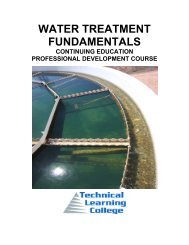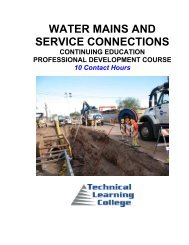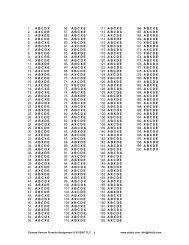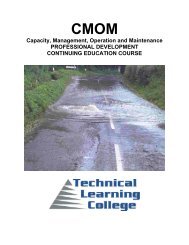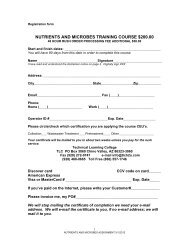Pump Primer 1 $100 - 8 Hours - Technical Learning College
Pump Primer 1 $100 - 8 Hours - Technical Learning College
Pump Primer 1 $100 - 8 Hours - Technical Learning College
Create successful ePaper yourself
Turn your PDF publications into a flip-book with our unique Google optimized e-Paper software.
Free Surface Perpendicular to Gravity<br />
When gravity acts, the liquid assumes a free surface perpendicular to gravity, which can be<br />
proved by Thomson's method. A straight cylinder of unit cross-sectional area (assumed only for<br />
ease in the arithmetic) can be used to find the increase of pressure with depth. Indeed, we see<br />
that p2 = p1 + ρgh. The upper surface of the cylinder can be placed at the free surface if<br />
desired. The pressure is now the same in any direction at a point, but is greater at points that lie<br />
deeper. From this same figure, it is easy to prove Archimedes’ Principle that the buoyant force is<br />
equal to the weight of the displaced fluid, and passes through the center of mass of this<br />
displaced fluid.<br />
Geometric Arguments<br />
Ingenious geometric arguments can be used to<br />
substitute for easier, but less transparent arguments<br />
using calculus. For example, the force acting on one<br />
side of an inclined plane surface whose projection is<br />
AB can be found as in the diagram on the previous<br />
page. O is the point at which the prolonged projection<br />
intersects the free surface. The line AC' perpendicular<br />
to the plane is made equal to the depth AC of point A,<br />
and line BD' is similarly drawn equal to BD. The line<br />
OD' also passes through C', by proportionality of<br />
triangles OAC' and OAD'. Therefore, the thrust F on<br />
the plane is the weight of a prism of fluid of crosssection<br />
AC'D'B, passing through its centroid normal to<br />
plane AB. Note that the thrust is equal to the density<br />
times the area times the depth of the center of the<br />
area; its line of action does not pass through the<br />
center, but below it, at the center of thrust. The same<br />
result can be obtained with calculus by summing the<br />
pressures and the moments.<br />
Atmospheric Pressure and its Effects<br />
Suppose a vertical pipe is stood in a pool of water,<br />
and a vacuum pump applied to the upper end. Before<br />
we start the pump, the water levels outside and inside the pipe are equal, and the pressures on<br />
the surfaces are also equal and are equal to the atmospheric pressure.<br />
Now start the pump. When it has sucked all the air out above the water, the pressure on the<br />
surface of the water inside the pipe is zero, and the pressure at the level of the water on the<br />
outside of the pipe is still the atmospheric pressure. Of course, there is the vapor pressure of<br />
the water to worry about if you want to be precise, but we neglect this complication in making<br />
our point. We require a column of water 33.9 ft high inside the pipe, with a vacuum above it, to<br />
balance the atmospheric pressure. Now do the same thing with liquid mercury, whose density at<br />
0 °C is 13.5951 times that of water. The height of the column is 2.494 ft, 29.92 in, or 760.0 mm.<br />
<strong>Pump</strong> <strong>Primer</strong> I Course © 12/1/2012 (866) 557-1746 www.ABCTLC.com<br />
22



